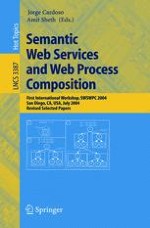Thisbookconstitutestherefereedproceedingsofthe1stInternationalWorkshop on Semantic Web Services and Web Process Composition, SWSWPC 2004, held at the Westin Horton Plaza Hotel, San Diego, California, USA, July 6, 2004, in conjunction with the IEEE International Conference on Web Services (ICWS 2004). Theworkshopintendedtobringresearchers,scientistsfrombothindustryand academics,andrepresentativesfromdi?erentcommunitiestogethertostudy,- derstand, and explore the phases that compose the lifecycle of Semantic Web processes. The workshop presented what can be achieved by the symbiotic s- thesis of two of the hottest R&D and technology application areas, Web services and the Semantic Web, as recognized at the 12th International World Wide Web conference (WWW 2003) and in the industry press. The emphasis of the workshop was mainly on Web services, Web processes and semantics which are important movements emerging in the World Wide Web. Web services and Web processes promise to ease several current infr- tructure challenges, such as data, application, and process integration. Web s- vices are truly platform-independent and allow the development of distributed, loosely coupled applications, a key characteristic for the success of dynamic Web processes.
